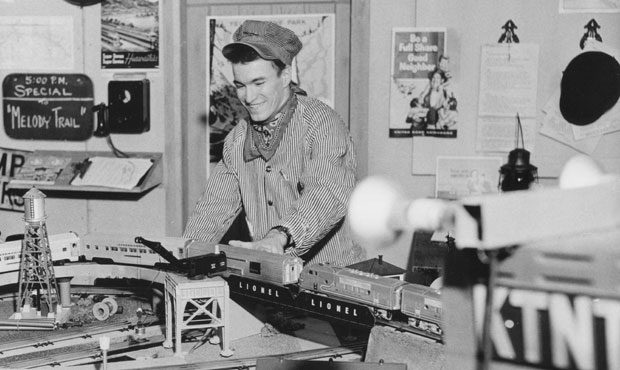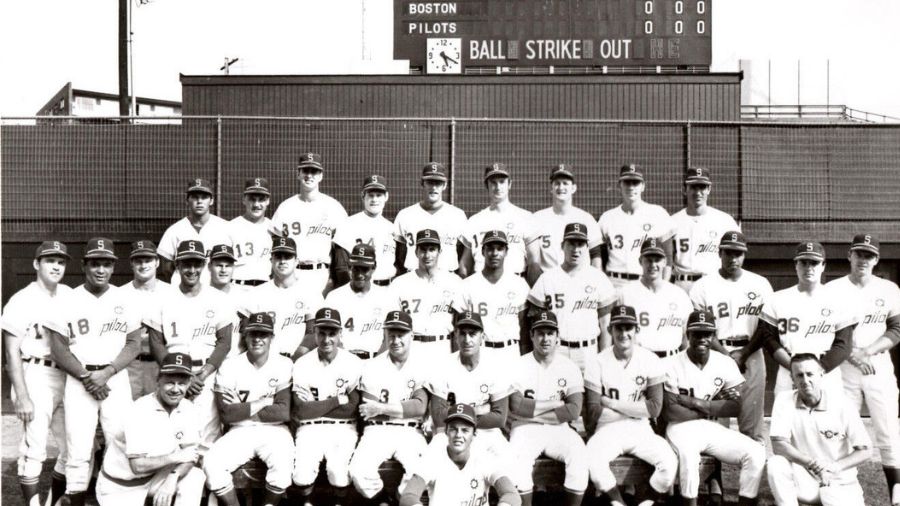Oregon family’s century of stories behind names of state’s towns, rivers, and mountains
Aug 25, 2021, 9:47 AM | Updated: 12:03 pm

The late Lewis L. McArthur took over for his father as "compiler" of a book about the origins of place-names in Oregon which was first published in 1928; his daughter Mary McArthur is working on the next edition. (Courtesy Oregon Historical Society)
(Courtesy Oregon Historical Society)
Since the 1920s, a family in Oregon has taken it upon themselves to research the history of how towns, rivers, and other geographic features in the Beaver State got their names, and then take what they’ve found and publish it all in what’s been a landmark reference work for nearly a century.
There are seven editions of Oregon Geographic Names published between 1928 and 2003, and all are now out of print. And this is a shame, because while the book is all about exactly what it sounds like it would be about, it’s not just some printed database. It’s well-written and engaging, and filled with stories about thousands of places and the people who named them.
Parts of Oregon Geographic Names are actually pretty funny, too.
Take, for example, why the Tillamook County community of “Oceanside” – right there on the coast, alongside and adjacent to the Pacific – is called that. “Nothing could be simpler than this,” reads the entry in its entirety.
There are similar place-name books for Washington, and there are books about Montana, and Idaho, and California geographic names – as there are for many of the 50 states. But the Oregon book stands out as something pretty special when considering the entire country.
“I’ve seen nothing like this [in any other state],” said Kerry Tymchuk, executive director of the Oregon Historical Society, the organization that has partnered with the McArthur family over the decades to publish the book.
“Oregon Geographic Names is the bible for Oregon history fans [and] geography fans,” Tymchuk told KIRO Radio on Tuesday. “It is just an amazing book, and encyclopedic in the information it presents about how each and every community, county, and geographic feature in Oregon got its name.”
“It’s a one-of-a-kind resource here in Oregon that many people use, obviously, for research purposes,” Tymchuk continued. “But a lot of people use it just for the fun of it because it’s so much fun to dive into how something got its name.”
The first three editions in the 1920s, 1940s, and 1950s were researched and written by Lewis A. McArthur – whose nickname was Tam. But he didn’t call himself the author; he instead used the term “compiler.”
Tam McArthur came from a family with deep interest in the history and geography of Oregon. In the 1920s, after a stint as a journalist, his day job was serving as an executive with Pacific Power & Light. This meant travel all over Oregon, with opportunities to gather maps, history books, and other resources, and talk with residents whose memories stretched back well into the 19th century.
Tam often took his son with him on those trips. As early as age 13, the younger McArthur did the driving, because Tam had chronic health problems. That son, Lewis L. McArthur, took over the book project when Tam passed away in 1951.
Lewis L. McArthur expanded Oregon Geographic Names and compiled a total of four editions from the 1970s to 2003. He was working on a new edition when he passed away three years ago this week at age 101, says his daughter Mary McArthur.
“This was a passion,” Mary McArthur told KIRO Radio earlier this week. “He was very meticulous about it, too. He was a historian – a purist historian. He would not put anything into that book that he didn’t feel that he had researched to the nth degree and was confident that it was correct.”
But, says his daughter, compiling place-name research and publishing new editions where his father had left off wasn’t all that Lewis L. McArthur was about.
“This man was remarkable — he really was,” Mary McArthur said. “His brain did not forget one thing that went into it. And he was an outdoorsman. He had a lot of friends, and all generations of friends. When he was in his last days he had people coming in that were 18 years of age just to say goodbye to him. It was just remarkable.”
Lewis McArthur, whose own day job had been with a steel-building company, had started to lose his sight when he was in his 90s. That’s when Mary decided she would help with the next edition, to keep the family tradition – and the beloved Oregon resource – going.
However, Mary McArthur says Oregon Geographic Names is not the same passion for her that it was for her father or her grandfather. But, she says, none of her other siblings were interested in taking over.
Does this mean that there was pressure to keep the project going?
“Yes and no,” Mary McArthur said. “I mean, it’s self-imposed pressure because I do feel that this is important. I do feel that this is something that needs to be current and relevant.”
Passion project or not, giving up, it seems, was not something Mary McArthur was ever going to consider.
Think of “the massive amount of work that’s gone into it,” Mary McArthur says, tallying the hours spent by her father and grandfather, and telling herself, as if giving a personal pep talk, “come on, step it up here. … I’m the high-energy person in my family anyway, so, you know, no worries.”
“I can get ‘er done,” she added.
It’s not surprising, then, to learn what the Oregon Historical Society’s Kerry Tymchuk thinks of Mary and her ancestors.
“There simply would not be this book without the McArthur family,” Tymchuk said. “There’s just no doubt about it.”
Before Tam McArthur ever compiled his first notes for the 1928 edition, the McArthur family has been deeply entangled in Oregon history for decades, longer than just about anyone besides the Indigenous people who have been there since time immemorial.
Tam’s grandfather James Nesmith came to Oregon Territory during the Great Migration of 1843, and later became one the first U.S. Senators from the state. Nesmith’s daughter – Tam McArthur’s mother, Harriet Nesmith McArthur – was one of the founders of the Oregon Historical Society.
Nowadays, Mary McArthur – like her father and grandfather before her – serves on the Oregon Geographic Names Board, the statewide body that reviews names of and name changes for geographic features.
Even in this capacity, the Beaver State connections run deep. Consider another member of the board who serves with Mary McArthur – a man named Champ Vaughn.
“His ancestor came across with James Nesmith, my great-great-grandfather,” Mary McArthur said. “Apparently, when they were crossing one of the rivers, Champ Vaughn’s great-great-grandfather’s horse tripped, or something like that, and he fell in.”
What happened next still reverberates for the descendants of the two men nearly 180 years later.
“My great-great-grandfather saved his life,” Mary McArthur said. “How weird is that? And so now we’re both on the Oregon Geographic Names Board together. Champ says, ‘Yeah, I wouldn’t be here if it wasn’t for your ancestor.’”
“That is kind of bizarre,” she added.
While Mary McArthur may say that Oregon Geographic Names isn’t her passion, she’s obviously very proud of what her father and grandfather did, and of what the book means to so many Oregonians and others with an interest in Pacific Northwest history, or the field of toponymy (the study of place-names).
“I’ll bet I mention the book in passing to someone at least once a week,” Mary McArthur said. “And I mean that I’m not just pulling it out of thin air – it’s always in context.”
So, how does it feel to be in Powell’s or some other Oregon bookstore and see a copy of an old edition on the shelf?
“It just feels great,” Mary McArthur said. “It’s like, ‘yeah!’”
But, she says, “the problem is you don’t see it very much anymore — you see some of the old editions, but nothing current.”
That’s why Mary McArthur is working on a new edition of Oregon Geographic Names, which she hopes to publish in 2023, in time for the 95th anniversary of the first edition.
“It is an important work for Oregon [and] is important for our family,” she said. “It would be criminal not to continue, and plus there is more to add to it. There is definitely an eighth edition that needs to be published.”
Since the previous edition was published in 2003, the Oregon Geographic Names Board, at the direction of state Legislature, has been removing what are now considered offensive names from mountain peaks, valleys, and other places. Around Oregon – as in Washington and other western states – there’s also been new focus by tribes to document and restore many Indigenous names on the landscape.
Not to get into the “woo-woo weeds,” as Mary McArthur describes it, but she does feel a personal link to that Oregon landscape that she can’t quite explain.
“When Oregon had a sesquicentennial [or 150th anniversary of the Great Migration] in 1993,” she said, “I walked the Oregon Trail from over in Eastern Oregon. I walked over Mount Hood and I walked into Oregon City, and I did feel a connection. I don’t know if it was real or imagined, but it was like, ‘yeah, you know, I feel like part of me has been here before, in some fashion.’”
“Woo-woo” feelings aside, Mary McArthur warns that when the next edition is published, it just might be the last printed version. She and her husband don’t have children, and there’s not an obvious fourth generation successor among her nieces and nephews. Add to this the fact that very few new names are being considered by the Oregon Geographic Names Board each year.
On top of all that, Mary McArthur points out, this is the digital age, and a big, thick, and expensive printed book can’t be the only way to present this material in the 2020s, especially if the goal is to make it relevant and accessible for younger audiences who are more accustomed to using apps than reading books.
Though Mary McArthur is pretty sure her dad wouldn’t agree about that digital part.
“Dad would be horrified,” she said. “He would say, ‘No, no, no. Never do that.’”
You can hear Feliks every Wednesday and Friday morning on Seattle’s Morning News, read more from him here, and subscribe to The Resident Historian Podcast here. If you have a story idea, please email Feliks here.













